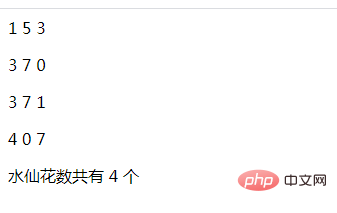Home >Backend Development >PHP Tutorial >PHP loop learning ten: Determine the number of daffodils and print the number of all daffodils
PHP loop learning ten: Determine the number of daffodils and print the number of all daffodils
- 青灯夜游Original
- 2021-08-16 11:39:167494browse
In the previous article "PHP Loop Learning 9: Obtaining the greatest common factor between two given numbers", we introduced to you how to use the while loop statement to find the given two numbers in the PHP program. The greatest common divisor between two integers, let’s continue learning about PHP loops~
This article mainly shows you, given a three-digit integer, how to determine whether the number is a narcissus number? Then how to output the total number of daffodils.
First let’s take a lookWhat is the narcissus number?
The Narcissus number is a 3-digit number, the sum of the 3rd power of the numbers in each digit is equal to itself (for example: 1^3 5^3 3^3 = 153) .
Let’s first look at how to determine whether a given three-digit number is a narcissus number?
Idea analysis:
According to the above we know: If a number $num is a narcissus number, then it must satisfy: The 3rd power of the ones digit The 3rd power of the tens digit The 3rd power of the hundreds digit = $num itself
Then we can first decompose $num to get Digit $g, tens digit$s, hundreds digit$b
then judge $g^3 $^3 $b ^3 Is it equal to $num
Let’s look at the implementation code:
<?php
header("Content-type:text/html;charset=utf-8");
function is_narcissistic ( $num ){
$b= intval($num/100);
$s= ($num/10)%10;
$g= $num%10;
// if($b*$b*$b+$s*$s*$s+$g*$g*$g==$num){ 等价于
if(pow($b,3)+pow($s,3)+pow($g,3)==$num){
echo $num."是水仙花数<br>";
}else{
echo $num."不是水仙花数<br>";
}
}
is_narcissistic(153);
is_narcissistic(152);
?>Output result:

In the above example, pow($b,3) and $b*$b*$b are equivalent, and both can calculate the cube of $b ( $b^3). pow(x,y)The function can return x raised to the yth power, that is, x^y.
We know that the daffodil number is a 3-digit number, so it has a quota. So how to calculate and output all the daffodil numbers? This requires the use of loops.
You can use a for loop to limit the range to between 100 and 1000. Writing method:
<?php
header("Content-type:text/html;charset=utf-8");
$i=0;
for ( $num = 100; $num < 1000; $num++){
$b= intval($num/100);
$s= ($num/10)%10;
$g= $num%10;
if(pow($b,3)+pow($s,3)+pow($g,3)==$num){
echo $num."<br>";
$i++;
}
}
echo "水仙花数共有 $i 个";
?>Look at the output:

Except In the above method of calculating and outputting the number of all daffodils, you can also use 3 for loops to traverse each digit to output the number of all daffodils:
<?php
header("Content-type:text/html;charset=utf-8");
$i=0;
for($q=1;$q<=9;$q++){
for($w=0;$w<=9;$w++){
for($e=0;$e<=9;$e++){
if($q*$q*$q + $w*$w*$w + $e*$e*$e ==
100*$q + 10*$w + $e){
echo "$q $w $e "."<p>";
$i++;
}
}
}
}
echo "水仙花数共有 $i 个";
?>Look at the output result:

It can be seen that the output results are the same.
It can be seen that we use a counter $num in the loop body of the for loop. After each time a three-digit palindrome number is output, it increases by 1, so that Count how many palindromes there are between 100 and 999.
Okay, that’s all. If you want to know anything else, you can click this. → →php video tutorial
The above is the detailed content of PHP loop learning ten: Determine the number of daffodils and print the number of all daffodils. For more information, please follow other related articles on the PHP Chinese website!
Related articles
See more- How to output all three-digit palindrome numbers through PHP program
- PHP cycle learning seven: two methods of printing 9*9 quick calculation table
- PHP loop learning eight: count the number of perfect numbers from 1 to 10,000, and output all perfect numbers
- PHP Loop Learning 9: Obtain the greatest common factor between two given numbers

